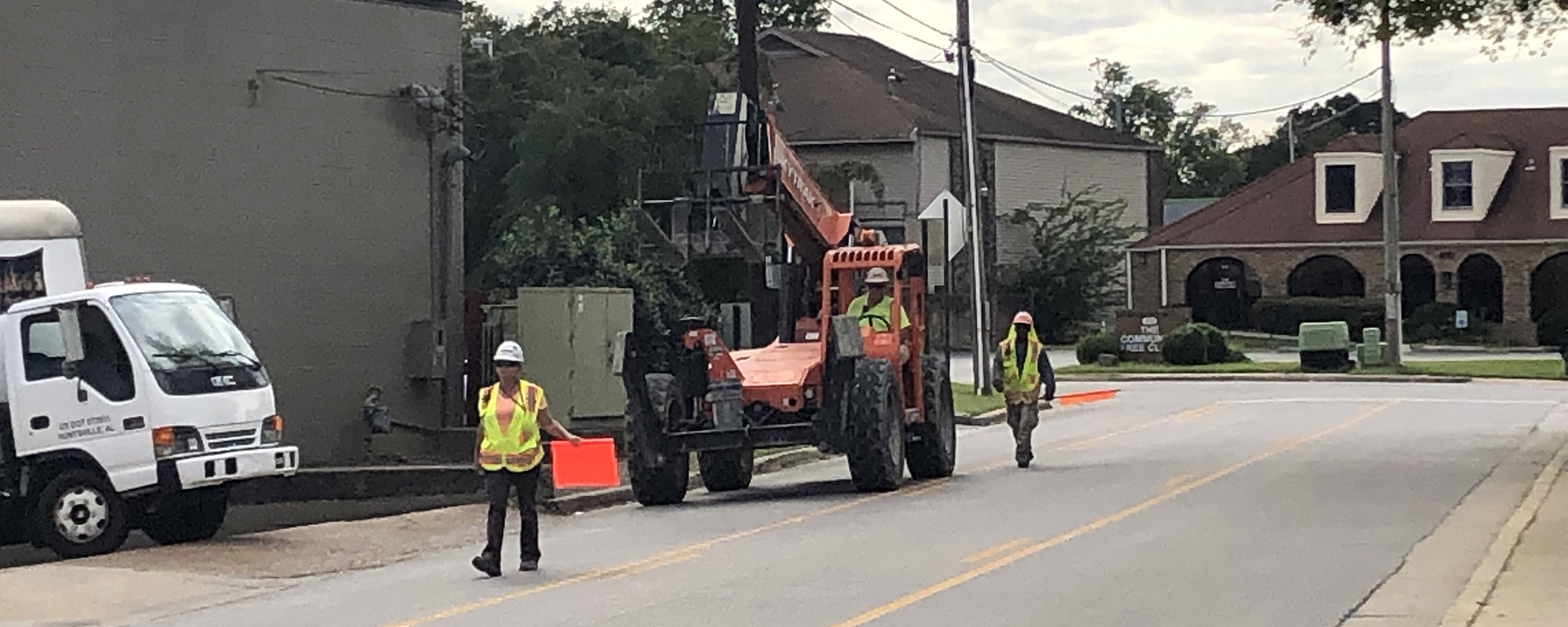It’s 2 a.m. The city of Huntsville, Alabama, is still shrouded in darkness, but on this particular morning, you can find Robins & Morton’s Huntsville Hospital Orthopedic and Spine Tower traffic control team awake and alert, directing concrete trucks onto the jobsite.
Using their radios and “lightsabers” – what they call their LED traffic batons – the team guides the looming forms down the material delivery route and into the project gate, while also coordinating any other pedestrian traffic coming and going from the hospital. Even though it slows down a little at night, hospitals are 24-hours-a-day, seven-days-a-week establishments – there are never really any “slow” times.
On these early mornings, the project team is in the process of pouring concrete slabs and decks – each time accomplishing one of 33 planned pours for the seven-story, 375,000-square-foot facility. Every pour requires a significant amount of concrete, which translates to convoy of trucks, and with concrete only remaining pourable for so long, the coordination of this task is far from simple. Keeping the trucks on route, in line and efficient is a big part of each flagger’s job, but to them, it’s all in a day’s work.
O n a more typical day, the flaggers – Leah Lorelle, Rhonda Kaikkonen, Bobby Sales, Archie White and Jerome Barnes – begin the day at 7 a.m. with a pretask meeting. Here, they discuss the day ahead, safety, upcoming deliveries and materials needed. After their task foundation is set, they’re off to their stations with their most valuable possessions in hand: their batons and their radios. Without these items, coordination with the public, the construction team, and each other becomes impossible.
n a more typical day, the flaggers – Leah Lorelle, Rhonda Kaikkonen, Bobby Sales, Archie White and Jerome Barnes – begin the day at 7 a.m. with a pretask meeting. Here, they discuss the day ahead, safety, upcoming deliveries and materials needed. After their task foundation is set, they’re off to their stations with their most valuable possessions in hand: their batons and their radios. Without these items, coordination with the public, the construction team, and each other becomes impossible.
From a roadside perspective, the innerworkings of a jobsite may seem linear, or even simple, but a project the size of Huntsville Hospital’s Orthopedic and Spine Tower currently has 85 workers onsite, all performing different trades or management functions. Each jobsite is like a small city, bustling with citizens, all contributing to the whole. Without everyone’s contributions, the mission can’t be achieved. Often, the traffic control team members are the gatekeepers to it all.
However, great responsibility comes with challenges and the flaggers accept that responsibility carefully. A common theme throughout every decision they make is safety – the safety of the public, hospital staff, their peers, the construction team, and themselves. The flaggers are well-practiced in this, as many of them have a construction background, but it’s a heightened kind of alertness you have to develop in their position, they explained. There’s a lot going on – traffic is waiting, some cars try to ignore you, the crane is picking, vendors are trying to deliver materials – and through all of that, you have to maintain a clear head and a focused mind.
“You can’t ever forget about what you’re doing,” Sales said. “You have to pay attention to everything around you at all times. You have people who are flying, trying to get somewhere… If you flag someone the wrong way, you can cause a major accident.”
Also, people skills are critical when choosing a career as a flagger, the team shared. Road closures, detours and waiting can make for a difficult navigational experience around a construction site because of the constant changing conditions, even though there are wayfinding signs. These feelings can intensify around a hospital, where people may be under stress or experiencing something highly emotional.
As a flagger, it’s important that to remain helpful when you’re working with the public, Barnes added.
“You have to interact with a lot of people that you don’t know,” Barnes continued. “They’re just trying to get to their destination. Stay humble, be kind, be nice, be friendly. Help them out the best way that you can.”
Working closely together whenever the job calls has forged a strong bond among Lorelle, Kaikkonen, Sales, White and Barnes. Robins & Morton Superintendent Jeff Jones said that their willingness to work together, no matter the task, really sets them apart as a team and makes them unique.
“Each of them is highly accountable to their job and to each other,” Jones said. “They understand the importance of what they do and how [they] represent Robins & Morton as a whole.”
For example, one night, Kaikkonen and Barnes had a scheduled shut down of the hospital’s visitor entrance, but in a quick turn of events, a heart became available for a transplant patient. They needed to find a way to get the on-call doctors, nurses, and other staff through the closure to perform the transplant. Working seamlessly with one another, Kaikkonen and Barnes formulated a plan to temporarily, but safely, open one lane of traffic, getting the staff into the hospital to perform the life-saving surgery.
Despite the challenges they face, this isn’t just a job to the flaggers. Each feels a deep personal responsibility and connection to the work they do each day.
“We do it for your safety,” Kaikkonen said. “We put our lives out in traffic to keep them safe.”
“It’s a great feeling,” Burns said. “We allow people to get to their destination, with no injuries, and we acted as a team to make this happen.”

